Search Results for 'story'
-
AuthorSearch Results
-
December 31, 2025 at 10:00 pm #8021
In reply to: The Hoards of Sanctorum AD26
Helier was the only one paying attention to Bartholomew, Cerenise noticed in a rare moment of focus on the proceedings at hand. A unique human (albeit an exceedingly long lived version of human) story was being revealed for the first time in near unprecedented circumstances, and he was relishing every moment of the revelations. That much was clear in a flash of understanding to Cerenise. Notwithstanding her propensity to jump to consclusions prematurely, she felt a moment of satisfaction and pleasure at the unexpected unfolding tale. Helier was as intrigued as she was, that much she knew.
December 31, 2025 at 11:11 am #8009In reply to: Finder’s Keepers of the Hoard
Some ideas for the background thread and character profiles for “The Hoards of Emporium 26.”
The Setting: Emporium 26
They live in Gloucester (ancient Glevum), a city built on Roman bones where the layout of the streets still follows the legions’ sandals. They inhabit a sprawling, shared Georgian townhouse complex that has been knocked through into one labyrinthine dwelling—Number 26.
To the outside world, it looks like a dilapidated heritage site. Inside, it is The Emporium: a geological stratification of history, where layers of Roman pottery are mixed with 1990s Beanie Babies and medieval reliquaries.
The Background Thread: “The Weight of Eternity”
Why do they hoard? Because when you live forever, “letting go” feels like losing a piece of the timeline. Hoarding objects is for them an accumulation of evidence of existence.
- The Curse: They cannot die naturally, but they can fade if they are forgotten. The “stuff” anchors them to the physical plane.
- The “Halo” Effect: Occasionally, when they are arguing over whose turn it is to do the dishes, or when they find a lost treasure, the stained-glass light of their old divinity flickers behind their heads—a neon halo of forgotten holiness.
The Hoarders & Their Stashes
1. Helier ( The Hermit / The Dreamer)
- Saintly Origin: Based on St. Helier (Jersey/Normandy). He was an ascetic hermit who lived in a cave and was eventually beheaded.
- Modern Persona: A soft-spoken agoraphobe who hasn’t left the house since the invention of the internet. He wears oversized cardigans that smell like old library books.
- The Mania: Escapism & Communication.
- Because he spent centuries in silence on a rock, he is now obsessed with human stories and noise.
- The Hoard: ” The Media Mountain.”
- His wing of the house is a fire hazard of pulp fiction, towering stacks of National Geographic (dating back to the first issue), thousands of VHS tapes (he has no VCR), and tangled knots of ethernet cables that he refuses to throw away “in case they fit a port from 1998.”
- The Secret Stash: Beneath a pile of “The Hoarder Vampires” novels lies his true relic: The Stone Pillow. The actual rock he slept on in the 6th century. He still naps on it when his back hurts.
2. Spirius (The Bishop / The Container)
- Saintly Origin: Evocative of St. Exuperius (Bayeux). A driver-out of demons and a man of grand gestures.
- Modern Persona: A nervous, fidgety man who is convinced the world is leaking. He is the “fixer” of the group but usually makes things worse with duct tape.
- The Mania: Containment & Preservation.
- In the old days, he bottled demons. Now, he’s terrified of running out of space to put things.
- The Hoard: “The Vessel Void.”
- Spirius hoards anything that can hold something else. Empty jam jars (washed, mostly), Tupperware with no matching lids, biscuit tins, and thousands of plastic carrier bags stuffed inside other carrier bags (the “Bag of Bags”).
- The Secret Stash: In a locked pantry, he keeps a shelf of sealed mason jars labeled with dates like “1431” or “1789.” He claims they contain the “Sigh of a King” or “The smell of rain before the Plague.” It’s actually just dust, but the jars vibrate slightly.
3. Cerenise (The Weaver / The Mender)
- Saintly Origin: Evocative of St. Ceneri or St. Cerneuf. A saint of travelers, or perhaps needlework.
- Modern Persona: She is the “Wheelchair Girl’s” friend mentioned in the intro? Or perhaps she is in a wheelchair now—not because she can’t walk, but because she’s too tired from walking for 1,500 years. She is sharp-tongued and fashionable in a “crazy bag lady” sort of way.
- The Mania: Potential & Texture.
- She sees the soul in broken things. She cannot throw away anything that “could be fixed.”
- The Hoard: “The Fabric of Time.”
- Her rooms are draped in layers of textiles: velvet curtains from a 1920s cinema, moth-eaten tapestries depicting her own miracles (she thinks the nose is wrong), and buttons. Millions of buttons. She also hoards broken appliances—toasters, lamps, clocks—insisting she will repair them “next Tuesday.”
- The Secret Stash: A mannequin dressed in a perfectly preserved Roman stola, hidden under forty layers of polyester coats. It’s the outfit she wore when she performed her first miracle. She tries it on every New Year’s Eve.
4. Yvoise (The Advocate / The Bureaucrat)
- Saintly Origin: Evocative of St. Yves (Patron of Lawyers/Brittany/Normandy). The arbiter of justice.
- Modern Persona: The “Manager” of Emporium 26. She wears power suits from the 80s and is always carrying a clipboard. She loves rules, even if she invents them.
- The Mania: Proof of Truth.
- She is terrified of being forgotten or cheated. She needs a receipt for everything.
- The Hoard: “The Archive of Nothing.”
- Yvoise hoards paper. Receipts from a coffee bought in 1952, bus tickets, expired warranties, junk mail, and legal disclaimers torn off mattresses. Her room looks like the inside of a shredder that exploded. She claims she is building “The Case for Humanity.”
- The Secret Stash: A filing cabinet labeled “Do Not Open.” Inside is not paper, but Seeds. Seeds from the trees of ancient Gaul. She is saving them for when the paper finally takes over the world and she needs to replant the forest she misses.
Starter: The Reading of Austreberthe’s Will
The story kicks off because Austreberthe (The Saint of Washing/Water) has died. Her hoard was Soap and Water.
- The house is now flooding because her magical containment on the plumbing has broken.
- The remaining four must navigate her “Tsunami Wing”—a treacherous dungeon of accumulated bath bombs, stolen hotel towels, and aggressive washing machines—to find her Will.
- The Will is rumored to reveal the location of the “Golden Key,” an object that can legally terminate their lease on Emporium 26, which none of them want, but all of them crave.
September 21, 2025 at 9:24 pm #7973In reply to: The Precious Life and Rambles of Liz Tattler
“Whatever happened to Miss Mossy Trotter, Finnley?” Liz asked, conversationally. She had a good idea what had happened to that innovative story writer, but she wanted to hear what Finnley had to say, before she mentioned it to Godfrey.
“What to YOU think happened to her?” Finnley responded, in her customary rudely intuitive manner.
“Sit down on that stool for a minute, and put the feather duster down,” Liz instructed, “And let’s have a talk about this because we both know that the possible ramifications don’t bear thinking about. Now then, sit still for five minutes and tell me everything.”
Unseen by either of them, Roberto had sidled up to the French windows and was peering inside, listening.
July 16, 2025 at 6:06 am #7969In reply to: The Elusive Samuel Housley and Other Family Stories
Gatacre Hall and The Old Book
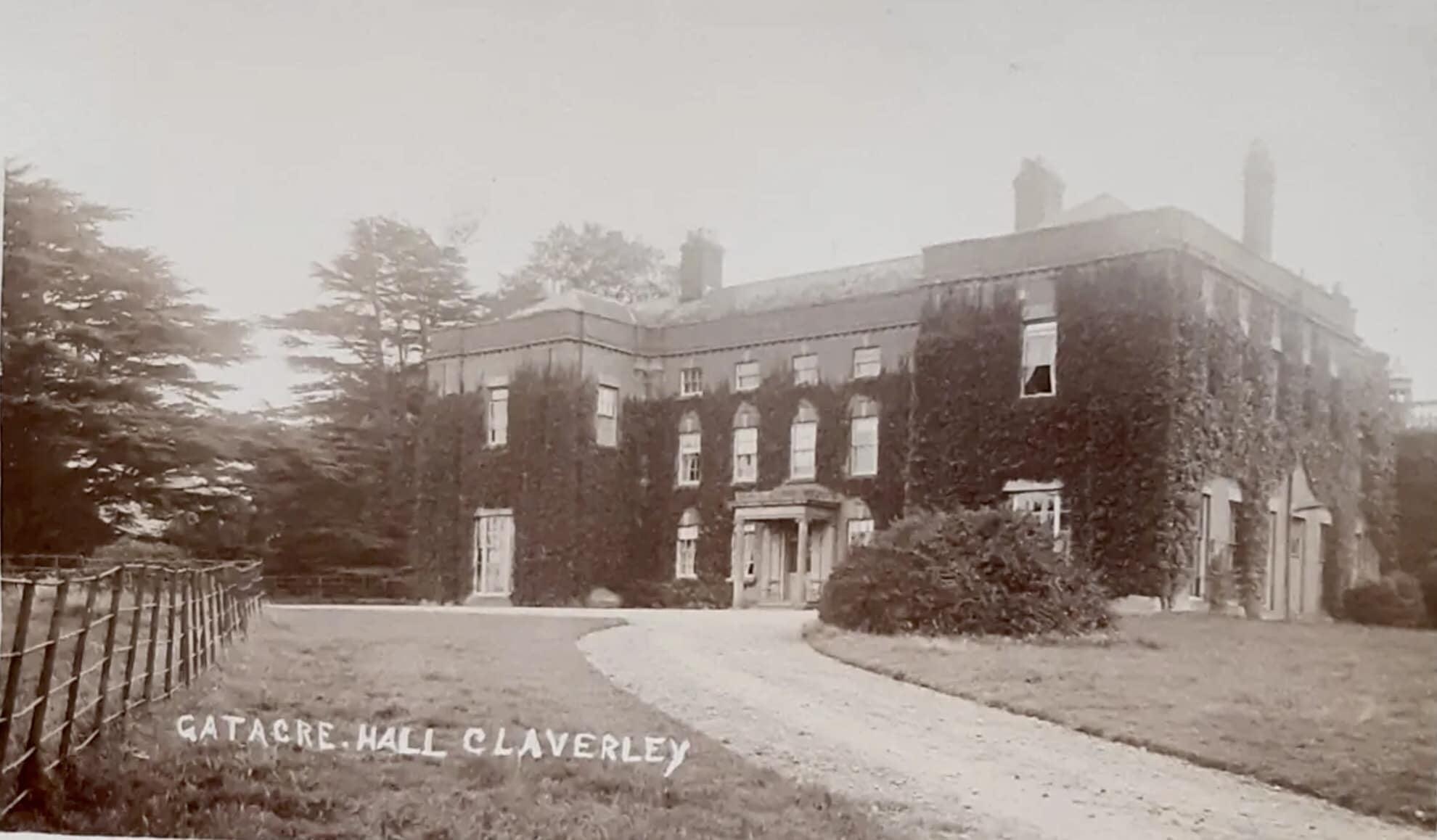
In the early 1950s my uncle John and his friend, possibly John Clare, ventured into an abandoned old house while out walking in Shropshire. He (or his friend) saved an old book from the vandalised dereliction and took it home. Somehow my mother ended up with the book.

I remember that we had the book when we were living in USA, and that my mother said that John didn’t want the book in his house. He had said the abandoned hall had been spooky. The book was heavy and thick with a hard cover. I recall it was a “magazine” which seemed odd to me at the time; a compendium of information. I seem to recall the date 1553, but also recall that it was during the reign of Henry VIII. No doubt one of those recollections is wrong, probably the date. It was written in English, and had illustrations, presumably woodcuts.
I found out a few years ago that my mother had sold the book some years before. Had I known she was going to sell it, I’d have first asked her not to, and then at least made a note of the name of it, and taken photographs of it. It seems that she sold the book in Connecticut, USA, probably in the 1980’s.
My cousin and I were talking about the book and the story. We decided to try and find out which abandoned house it was although we didn’t have much to go on: it was in Shropshire, it was in a state of abandoned dereliction in the early 50s, and it contained antiquarian books.
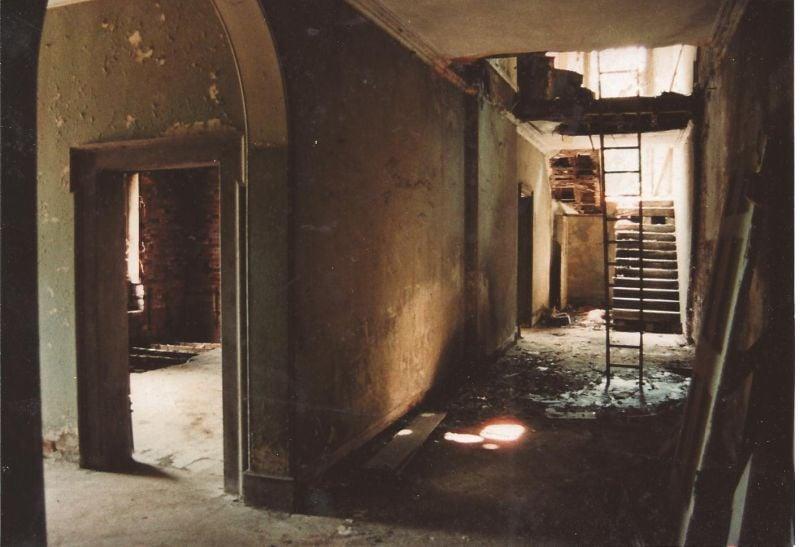
I posted the story on a Shropshire History and Nostalgia facebook group, and almost immediately had a reply from someone whose husband remembered such a place with ancient books and manuscripts all over the floor, and the place was called Gatacre Hall in Claverley, near Bridgnorth. She also said that there was a story that the family had fled to Canada just after WWII, even leaving the dishes on the table.
The Gatacre family sailing to Canada in 1947:
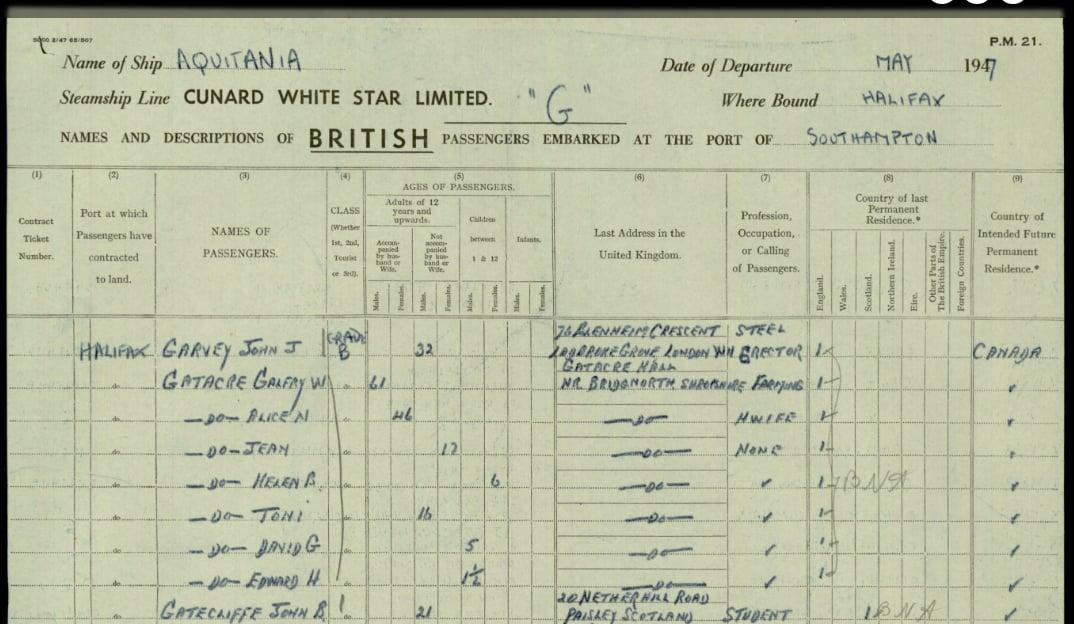
When my cousin heard the name Gatacre Hall she remembered that was the name of the place where her father had found the book.
I looked into Gatacre Hall online, in the newspaper archives, the usual genealogy sites and google books searches and so on. The estate had been going downhill with debts for some years. The old squire died in 1911, and his eldest son died in 1916 at the Somme. Another son, Galfrey Gatacre, was already farming in BC, Canada. He was unable to sell Gatacre Hall because of an entail, so he closed the house up. Between 1945-1947 some important pieces of furniture were auctioned, and the rest appears to have been left in the empty house.
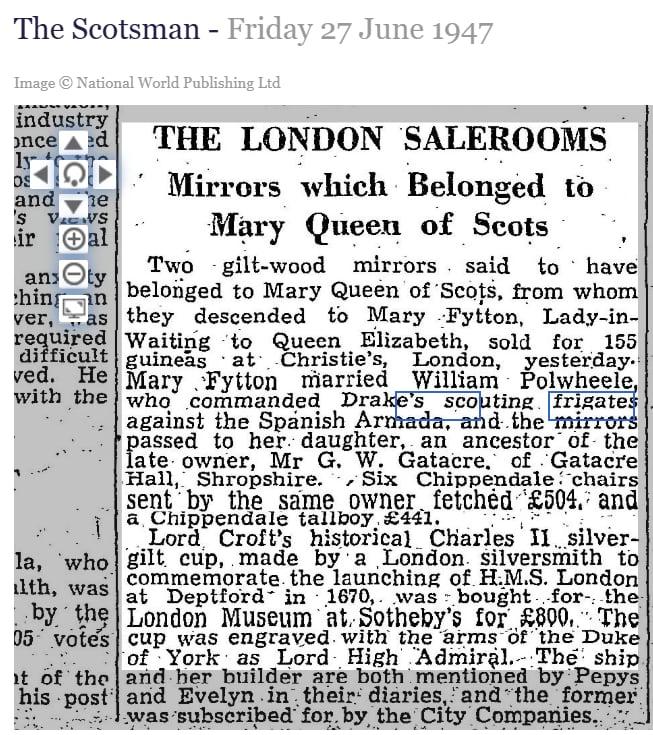
The family didn’t suddenly flee to Canada leaving the dishes on the table, although it was true that the family were living in Canada.
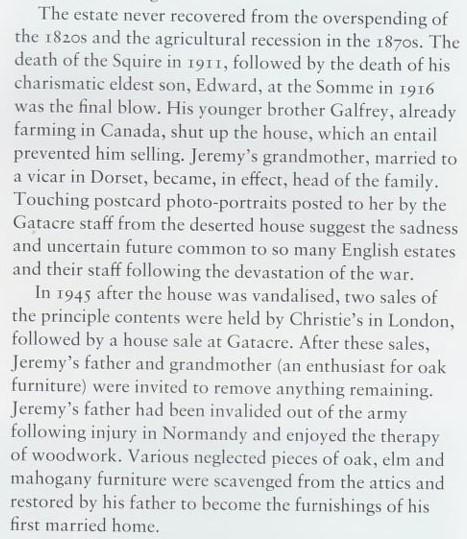
An interesting thing to note here is that not long after this book was found, my parents moved to BC Canada (where I was born), and a year later my uncle moved to Toronto (where he met his wife).
Captain Gatacre in 1918:

The Gatacre library was mentioned in the auction notes of a particular antiquarian book:
“Provenance: Contemporary ownership inscription and textual annotations of Thomas Gatacre (1533-1593). A younger son of William Gatacre of Gatacre Hall in Shropshire, he studied at the English college at the University of Leuven, where he rejected his Catholic roots and embraced evangelical Protestantism. He studied for eleven years at Oxford, and four years at Magdalene, Cambridge. In 1568 he was ordained deacon and priest by Bishop of London Edmund Grindal, and became domestic chaplain to Robert Dudley, 1st Earl of Leicester and was later collated to the rectory of St Edmund’s, Lombard Street. His scholarly annotations here reference other classical authors including Plato and Plutarch. His extensive library was mentioned in his will.”


There are thirty four pages in this 1662 book about Thomas Gatacre d 1654:
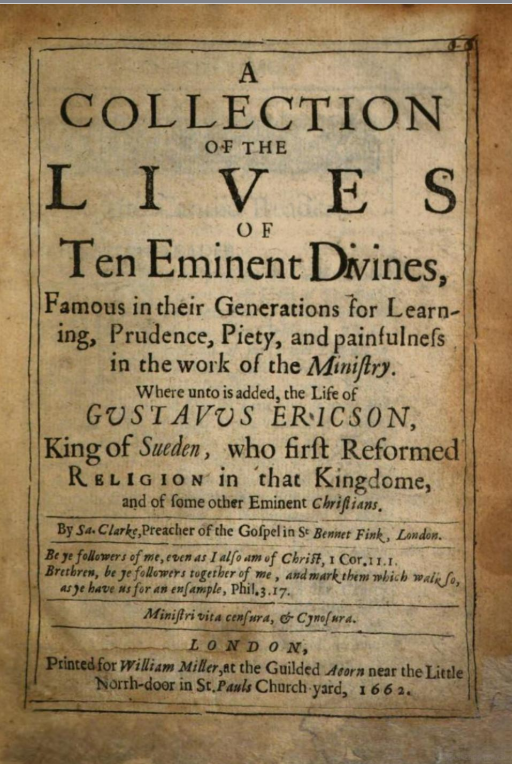
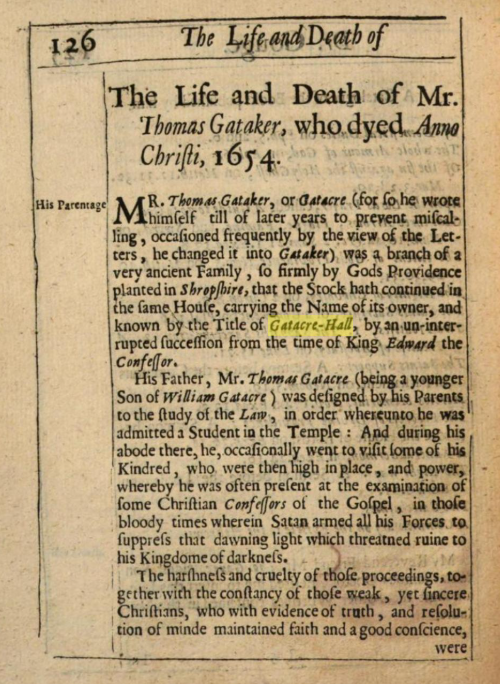 June 22, 2025 at 7:50 pm #7966
June 22, 2025 at 7:50 pm #7966In reply to: Cofficionados Bandits (vs Lucid Dreamers)
“Ricardo!” Amy said with a raised eyebrow and a note of surprise in her voice. “All I’ve ever seen you do so far is lurk in bushes sending secret messages. But I admire your bold assertiveness, I can see you are on a sudden quest to discover your true potential.” Amy smiled encouragingingly and patted his shoulder. “The sooner we get the gazebo back the better, The Padre is recovering and anxious to host The Character Building Party.”
His chest swelling with pride, Ricardo replied that he was very grateful for her support and attention, and would do his best to restore both the gazebo and his independence, but that he was in a quandary about the conflict of interests between his role in the story, and his value fulfilment as a developing character.
“Yeah that’s a tough one,” Amy said, “But it’s a good question to ask at the party in the gazebo. Hurry and get the gazebo back!”
June 14, 2025 at 8:13 pm #7963In reply to: Cofficionados Bandits (vs Lucid Dreamers)
“Well, I think that proves my point,” remarked Carob with a smirk.
“What do you mean”, Thiram said crossly, which sounded more like a resigned sigh than a question.
“Remember what I said? You can’t order a synchronicity, or expect one. They always just happen when you don’t expect it.”
“She’s right,” Any piped up. “We can’t just sit here waiting for a coincidence. We have to just carry on regardless until one appears.”
“Aunt Amy?” Kit asked, “How do we carry on regardless if we don’t know what our story is yet?”
“What I want to know is this,” Chico said with a twirl of his worry beads, “Who’s coming with me to fetch the gazebo back?” Chico squared his shoulders proudly, glad that his new colourful beads had replaced the urge to spit. He felt in control, a new man. A man to be respected. A leader.
With an elaborate triple reverse double flip of the worry beads, Chico turned and strode purposefully into the sunset, in the direction of the gazebo.
June 6, 2025 at 6:02 pm #7954In reply to: Cofficionados Bandits (vs Lucid Dreamers)
Another one! A random distant memory wafted into Amy’s mind. Uncle Jack always used to say GATZ e bo. Amy could picture his smile when he said it, and how his wife always smiled back at him and chuckled. Amy wondered if she’d even known the story behind that or if it had always been a private joke between them.
“What’s been going on with my gazebo?” Amy’s father rushed into the scene. So that’s what he looks like. Amy couldn’t take her eyes off him, until Carob elbowed her in the neck.
“Sorry, I meant to elbow you in the ribs, but I’m so tall,” Carob said pointlessly, in an attempt to stop Amy staring at her father as if she’d never seen him before.
Thiram started to explain the situation with the gazebo to Amy’s father, after first introducing him to Kit, the new arrival. “Humphrey, meet Kit, our new LBGYEQCXOJMFKHHVZ story character. Kit, this is Amy’s father who we sometimes refer to as The Padre.”
“Pleased to meet you, ” Kit said politely, quaking a little at the stern glare from the old man. What on earth is he wearing? A tweed suit and a deerstalker, in this heat! How do I know that’s what they’re called? Kit wondered, quaking a little more at the strangeness of it all.
“Never mind all that now!” Humphrey interrupted Thiram’s explanation.
Still as rude as ever! Amy thought.
“I’ve too much to think about, but I’ll tell you this: I’ve planned a character building meeting in the gazebo, and you are all invited. As a matter of fact,” Humphrey continued, “You are all obliged to attend. If you choose not to ~ well, you know what happened last time!”
“What happened last time?” asked Carob, leaning forward in anticipation of an elucidating response, but Humphrey merely glared at her.
Amy sniggered, and Humphrey shot her a lopsided smile. “YOU know what happened in Jack’s GATZ e bo, don’t you, my girl?”
Where were those random memories when you wanted them? Amy had no idea what he was talking about.
“Who else is invited, Humph? asked Chico, resisting the urge to spit.
“My good man,” Humphrey said with a withering look. “Sir Humphrey’s the name to you.”
Sir? what’s he on about now? wondered Amy. Does that make me a Lady?
“Who else is invited, Padre?” Amy echoed.
Humphrey pulled a scroll tied with a purple ribbon out of his waistcoat pocket and unfurled it. Clearing his throat importantly, he read the list to all assembled.
Juan and Dolores Valdez.
Godric, the Swedish barman
Malathion and Glyphosate, Thiram’s triplet brothers. Mal and Glyph for short.
Liz Tattler
Miss Bossy Pants
Goat Horned Draugaskald“Did I forget anyone?” Humphrey asked, peering over his spectacles as he looked at each of the characters. “You lot,” he said, “Amy, Carob, Thiram, Chico, Kit and Ricardo: you will be expected to play hosts, so you might want to start thinking about refreshments. And not,” he said with a strong authoritarian air, “Not just coffee! A good range of beverages. And snacks.”
Thiram, leaning against a tree, started whistling the theme tune to Gone With The Wind. Tossing an irritated glance in his direction, Carob roughly gathered up her mass of frizzy curls and tethered it all in a tight pony tail. I still don’t know what happened before, she fumed silently. The latest developments where making her nervous. Would they find out her secret?
“You guys,” called Chico, who had wandered over to the gazebo. “It’s full of ants.”
May 23, 2025 at 9:19 pm #7951In reply to: Cofficionados Bandits (vs Lucid Dreamers)
Disgruntled and bored with the fruitless wait for the other characters to reveal more of themselves, Amy started staying in her room all day reading books, glad that she’d had an urge to grab a bag full of used paperbacks from a chance encounter with a street vendor in Bogota.
A strange book about peculiar children lingered in her mind, and mingled somehow with the vestiges of the mental images of the writhing Uriah in the book Amy had read prior to this one.
Aunt Amy? a childs voice came unbidden to Amys ear. Well, why not? Amy thought, Some peculiar children is what the story needs. Nephews and neices though, no actual children, god forbid.
“Aunt Amy!” A gentle knocking sounded on the bedroom door. “Are you in there, Aunt Amy?”
“Is that at neice or nephew at my actual door? Already?” Amy cried in amazement.
“Can I come in, please?” the little voice sounded close to tears. Amy bounded off the bed to unloock leaving that right there the door to let the little instant ramen rellie in.
The little human creature appeared to be ten years old or so, as near as Amy could tell, with a rather androgenous look: a grown out short haircut in a nondescript dark colour, thin gangling limbs robed in neutral shapelessness, and a pale pinched face.
“I’ve never done this before, can you help me?” the child said.
“Never been a story character before, eh?” Amy said kindly. “Do you know your name? Not to worry if you don’t!” she added quickly, seeing the child’s look of alarm. “No? Well then you can choose what ever you like!”
The child promptly burst into tears, and Amy wanted to kick herself for being such a tactless blundering fool. God knows it wasn’t that easy to choose, even when you knew the choice was yours.
Amy wanted to ask the child if it was a boy or a girl, but hesitated, and decided against it. I’ll have to give it a name though, I can’t keep calling it the child.
“Would you mind very much if I called you Kit, for now?” asked Amy.
“Thanks, Aunt Amy,” Kit said with a tear streaked smile. “Kit’s fine.”
May 13, 2025 at 8:05 pm #7933In reply to: Cofficionados Bandits (vs Lucid Dreamers)
Where did that come from? Amy wondered. The random memories, if that’s what they were, were coming more frequently. Suddenly, out of nowhere and with no discernable correlation to the present moment in the life of the newly hatched character, a sudden mirage in her minds eye appeared, enticing and utterly fascinating.
I’m just a story character with no back story, where are these memories coming from?
“You should see some of the memories I’m starting to see, and I’m even less developed as a character than you are,” Chico said, manfully resisting the urge to spit. He didn’t want to be a spitting character, not all the time, anyway.
Amy was startled. I didn’t say that out loud. Did I say it out loud?
“Confusing at times, isn’t it?” Chico said kindly.
May 10, 2025 at 10:01 am #7931In reply to: Cofficionados Bandits (vs Lucid Dreamers)
Carob wrinkled her nose in distaste and languidly remarked, “Amy, that goaty odour seems to be emanating from your clothing. Does it perchance require laundering?”
Chico laughed loudly, spitting equally audibly. “Hi,” he said, “The name’s Chico,” emerging from behind the tulip tree.
Carob winced at the spitting, and Amy writhed a little at being humiliated in front of the man. They both ignored him, and he regretted not staying hidden.
“I’ve just pegged out two loads of washing, for your information, not that it will dry in this rain,” Amy said, quickly tying her hair back in annoyance. Does this move the story forward? she wondered. Why do I have a smelly character anyway? I’m sweaty, goaty and insecure, how did it happen?
“Never mind that anyway, have you seen what’s on todays news?” Carob asked, feeling sorry for making Amy uncomfortable.
“I have,” remarked Chico, with a hopeful expression, but the women ignored him.
May 10, 2025 at 7:56 am #7921In reply to: Cofficionados – What’s Brewing
Key Themes and Narrative Elements
Metafiction & Self-Reference: Characters frequently comment on their own construction, roles, and how being written (or observed) defines their reality. Amy especially embodies this.
Lucid Dreaming & Dream Logic: The boundary between reality and dream is porous. Lucid Dreamers are parachuting onto plantations, and Carob dreams in reverse. Lucid Dreamers are adverse to Coffee Plantations as they keep the World awake.
Coffee as Sacred Commodity: The coffee plantation is central to the story’s stakes. It’s under threat from climate (rain), AI malfunctions, and rogue dreamers. This plays comically on global commodity anxiety.
Technology Satire & AI Sentience: Emotional AI, “Silly Intelligence” devices, and exasperation with modern tech hint at mild technophobia or skepticism. All fueled by hot caffeinated piece of news.
Fictionality vs. Reality: Juan and Dolores embody this—grappling with what it means to be real. Dolores vanishes when no one looks—existence contingent on observation.
Rain & Weather as Mood Symbol: The rain is persistent—setting a tone of gentle absurdity and tension, while also providing plot catalyst.
May 10, 2025 at 7:51 am #7920In reply to: Cofficionados – What’s Brewing
Key Characters (with brief descriptions)
Amy Kawanhouse – Self-aware new character with metatextual commentary. Witty, possibly insecure, reflective; has a goat named Fanella and possibly another, Finnley, for emergencies. Often the first to point out logical inconsistencies or existential quirks.
Carob Latte – Tall, dry-humored, and slightly chaotic. Fond of coffee-related wordplay and appears to enjoy needling Amy. Described as having “frizzled” hair and reverse-lucid dreams.
Thiram Izu – The practical one, technologically inclined but confused by dreams. Tends to get frustrated with the group’s lack of coordination. Has a history of tension with Amy, and a tendency to “zone out.”
Chico Ray – Mysterious newcomer. May have appeared out of nowhere. Unclear loyalties. Possibly former friend or frenemy of the group, annoyed by past incidents.
Juan & Dolores Valdez – Fictional coffee icons reluctantly acknowledging their existence within a meta-reality. Dolores isn’t ready to be real, and Juan’s fine with playing the part when needed.
Godric – Swedish barista-channeler. Hints at deeper magical realism; references Draugaskalds (ghost-singers) and senses strange presences.
Ricardo – Appears later. Described in detail by Amy (linen suit, Panama hat), acts as a foil in a discussion about maps and coffee geography. Undercover for a mission with Miss Bossy.
The Padre – Could be a father or a Father. Offstage, but influential. Concerned about rain ruining crops. A source of exposition and concern.
Fanella – Amy’s cream goat, serves as comic relief and visual anchor.
Finnley, the unpredictable goat, is reserved for “life or death situations.”May 7, 2025 at 5:52 am #7916In reply to: Cofficionados Bandits (vs Lucid Dreamers)
Carob didn’t know what to say — which gave her a tendency to ramble.
Was everyone avoiding Amy?
Was it because she was dressed as a stout little lady?
Carob cleared her throat. “Well, Amy, you look… most interesting today.”
“I have to agree,” replied Amy, unperturbed. “Now — what is this about you and Ricardo?”
“I’m sorry, but I can’t tell you,” Carob said, shaking her head. “Partly because it’s top secret, and partly because…”
She tapped her temple and nodded to herself — definitely a few times more than necessary. “I’m still working it out.”“But you know him?” Amy persisted. “How do you know him?”
Carob knew Amy could be relentless.
“Look over there!” she shouted, pointing vaguely.
Amy didn’t even turn her head. She gazed up at Carob with a long-suffering stare. “Carob?”
Carob scrunched up her face. “Okay,” she said eventually. “I think the others are avoiding you. Me. Us. Both of us.”
She took a deep breath. “Thiram doesn’t know where we are or what we’re doing here — and he’s not good with that, bless. We don’t know where on earth Chico is — but we do know he spits, which, quite frankly, is uncouth.”
She brightened suddenly. “But one thing I do know — here, amid the coffee beans and the lucid dreamers, there is a story to be told.”
Amy rolled her eyes. “I’ve noticed you still haven’t told me how you know Ricardo.”

It was rather odd — but neither of them noticed the bush inching closer.
Trailing suspect but nothing to report yet, messaged Ricardo.
He knew Miss Bossy Pants wouldn’t be happy.
April 21, 2025 at 6:36 pm #7900In reply to: Cofficionados Bandits (vs Lucid Dreamers)
Amy excused herself and went off to find a lavatory. She didn’t actually need to go, after all she had only just popped into existence and hadn’t been offered a drink yet. But she did want to find a mirror to see what basic character characteristics she had had bestowed upon her when the story character gods had been assigning new players. She had to act fast too, before some other new story character might see her and describe her to the readers before she had even seen her self herself.
Amy was quite glad to not have to learn new pronouns at this juncture.
April 20, 2025 at 9:25 pm #7897In reply to: Cofficionados Bandits (vs Lucid Dreamers)
To Whom It May Concern
I know you’re writing stories and making things up about me, and I intend to set the record straight before my character goes horribly awry. I am a character appeared from nowhere, from a reckless and inebriated momentary random insistence on a new plaything, and new toy, and new story. But let me tell you this: I am born and I exist and this is who I am.
I find my name is Amy; it will do. I neither find an affinity to it, nor an objection. It sounds English, and thus, familiar. I feel English, and so I am. I am a character, not a writer, but I exist; I am Amy.
April 20, 2025 at 11:24 am #7896In reply to: Cofficionados Bandits (vs Lucid Dreamers)
“Juan, was it wise to speak to that man?” Dolores asked her husband. “The cat’s out of the bag now, when Chico tells his friends…”
“Trust me, Dolores,” Juan Valdez implored, “What else can we do? We need their help.”
“But you’ve been fictional for so long, Juan. Nobody knew you were real. Until now.”
“You worry too much! It’s hardly going to make headlines on Focks News, is it, and even if it did, nobody believes anything anymore. We can just spread a rumour that it was made up by one of those artifical story things.”
“But he took a photo of you!”
“Dolores,” Juan said with exaggerated patience, “Nobody believes photos any more either. I’m telling you, they make fakes these days and nobody can tell. Trust me,” he repeated, giving her shoulder a reassuring squeeze.
“So we’ll still be fictional, Juan?” Dolores asked in an uncertain tone. “Because I’m not ready to be a real character yet, it seems so….so time consuming, to be real every day, all day… doing all those things every day that real people do…”
“No, no, not at all! You only have to play the part when someone’s looking!”
“I hope you’re right. Too many things changing all at once, if you ask me.” And with that Dolores vanished, as nobody was looking at her.
March 23, 2025 at 10:50 am #7880In reply to: The Precious Life and Rambles of Liz Tattler
“Nice arse,” said Idle non too quietly, admiring Roberto as he stacked firewood beside the hearth. The gardener glanced round and gave her a cheeky wink. He’d noticed her leaning out of an upstairs window watching him weeding the herbacious border.
“Now, now, Idle, no molesting the staff. I’ll write some men into the story for you later,” Liz said, “But first let’s talk about my new book. I’m wondering what to name the six spinsters. Some kind of a theme. Cerise, Fuschia, Scarlett, Coral, Rose and Magenta?”
“What about Cobalt, Lapis, Cerulean, Indigo, Sapphire and Capri?” offered Idle, topping up their wine glasses. “Chartreuse, Emerald, Jade, Fern, Pistachio and Malachite? Marigold, Saffron, Citron, Amber, Maize and Apricot?”
“How about Bratwurst, Chorizo, Salami, Knackwurst, Bologna and Frankfurter?” suggested Godfrey who was still miffed about all the spare parts being disposed of. “Lasagne, Macaroni, Canneloni, Farfali, Linguini and Ravioli?”
Roberto lit the fire and stood up. “I have an idea, you can call them Trowel, Rake, Hoe, Wheelbarrow, Spade and Secateur.”
“Marvelous Roberto, I love it!” gushed Aunt Idle.
“You’re all mad as a box of frogs, madder than Almad,” Finnley said. “How about Duster, Mop, Bleach, Broom, Dustpan and Cloth?”
“I think this incessant rain is driving us all mad,” Liz said, glancing out of the French windows with a sigh.
March 23, 2025 at 10:18 am #7879In reply to: The Precious Life and Rambles of Liz Tattler
Moments later, Finnley returned. “There’s a woman at the door. With suitcases. Says you invited her to stay. Nobody told me you were expecting guests.”
“Did you ask who it was?”
“Don’t you know who you invited? She’s a thin woman with awful dreadlocks, too old for dreads if you ask me, speaks with an Australian accent.”
“Ah yes, one of my favourite story characters! She’s come to help me with my new novel.”
“But what about the bedding? Nobody told me to get a bedroom ready for guests,” Finnley replied.
Just then a pretty young French maid appeared through the French windows. “I ‘ave come to ‘elp wiz ze bedding!”
“Fanella, right on cue! Come in dear, and go and help Finnley ~ Finnley, have you shown Aunt Idle in? Take her to the drawing room and I’ll be in directly, then go and help Fanella. And if you’re not careful, I may give Fanella your job, at least she’s willing and doesn’t complain all the time. And take that silly orange mask off, you look a fright.”
March 23, 2025 at 7:37 am #7878In reply to: The Precious Life and Rambles of Liz Tattler
Liz threw another pen into the tin wastepaper basket with a clatter and called loudly for Finnley while giving her writing hand a shake to relieve the cramp.
Finnley appeared sporting her habitual scowl clearly visible above her paper mask. “I hope this is important because this red dust is going to take days to clean up as it is without you keep interrupting me.”
“Oh is that what you’ve been doing, I wondered where you were. Well, let’s thank our lucky stars THAT’S all over!”
“Might be over for you,” muttered Finnley, “But that hare brained scheme of Godfrey’s has caused a very great deal of work for me. He’s made more of a mess this time than even you could have, red dust everywhere and all these obsolete parts all over the place. Roberto’s on his sixth trip to the recycling depot, and he’s barely scratched the surface.”
“Good old Roberto, at least he doesn’t keep complaining. You should take a leaf out of his book, Finnley, you’d get more work done. And speaking of books, I need another packet of pens. I’m writing my books with a pen in future. On paper. Oh and get me another pack of paper.”
Mildly curious, despite her irritation, Finnely asked her why she was writing with a pen on paper. “Is it some sort of historical re enactment? Would you prefer parchment and a quill? Or perhaps a slab of clay and some etching tools? Shall we find you a nice cave,” Finnley was warming to the theme, “And some red ochre and charcoal?”
“It may come to that,” Liz replied grimly. “But some pens and paper will do for now. Godfrey can’t interfere in my stories if I write them on paper. Robots writing my stories, honestly, who would ever have believed such a thing was possible back when I started writing all my best sellers! How times have changed!”
“Yet some things never change, ” Finnley said darkly, running her duster across the parts of Liz’s desk that weren’t covered with stacks of blue scrawled papers.
“Thank you for asking,” Liz said sarcastically, as Finnley hadn’t asked, “It’s a story about six spinsters in the early 19th century.”
“Sounds gripping,” muttered Finnley.
“And a blind uncle who never married and lived to 102. He was so good at being blind that he knew all his sheep individually.”
“Perhaps that’s why he never needed to marry,” Finnley said with a lewd titter.
“The steamy scenes I had in mind won’t be in the sheep dip,” Liz replied, “Honestly, what a low degraded mind you must have.”
“Yeah, from proof reading your trashy novels,” Finnley replied as she flounced out in search of pens and paper.
March 22, 2025 at 3:38 pm #7877In reply to: The Last Cruise of Helix 25
Helix 25 — The Six Spinster Sisters’ Will
Evie keyed in her login credentials for the sixth time that afternoon, stifling a yawn. Ever since the murder case had wrapped, she had drifted into a lulling routine—one that made her pregnancy drag on with excruciating slowness. Riven was rarely around; he’d been commandeered by the newly awakened Veranassessee for “urgent duties” that somehow never needed Evie’s help. And though she couldn’t complain about the ship’s overall calm, she felt herself itching for something—anything—to break the monotony.
So she’d come to one of the less-frequented data terminals on Helix25, in a dim corner off the main library deck. She had told herself she was looking up baby name etymologies (her mother would have pressed her about it), but she’d quickly meandered into clinically sterile subfolders of genealogical records.
It was exactly the kind of aimless rummaging that had once led her to uncover critical leads during the murder investigation. And if there was something Helix25 had in abundance besides well-recycled air, it was obscure digital archives.
She settled into the creaking seat, adjusting the small pillow behind her back. The screen glowed, lines of text scrolling by in neat greenish typeface. Most references were unremarkable: old Earth deeds, ledgers for farmland, family names she didn’t recognize. Had she not known that data storage was near infinite, due to the excess demands of data from the central AIs, she would have wondered why they’d bothered stocking the ship with so much information. Then her gaze snagged on a curious subfolder titled “Alstonefield Will—Gibbs Sisters.”
“Gibbs Sisters…?” she murmured under her breath, tapping it open.
The file contained scans of a handwritten will dated early 1800s, from Staffordshire, England. Each page was peppered with archaic legalese (“whereupon the rightful property of Misses Mary, Ellen, Ann, Sarah, Margaret and Malové Gibbs bequeathed…”), listing items that ranged from modest farmland acreage to improbable references of “spiritual confidences.”
Evie frowned, leaning closer. Spiritual confidences? The text was surprisingly explicit about the sisters’ lives—how six women jointly farmed 146 acres, remained unmarried, and according to a marginal note, “were rumored to share an uncanny attunement of thought.”
A telepathic link? she thought, half-intrigued, half-smirking. That smacked of the same kind of rumor-laden gossip that had swirled around the old Earth families. Still, the note was written in an official hand.
She scrolled further, expecting the record to fizzle out. Instead, it abruptly jumped to an addendum dated decades later:
“By 1834, the Gibbs sisters departed for the Australian continent. Certain seeds and rootstocks—believed essential for their ‘ancestral devotions’—did accompany them. No further official records on them remain in Staffordshire….”
Seeds and rootstocks. Evie’s curiosity piqued further—some old detail about hush-hush crops that the sisters apparently treasured enough to haul across the world.
A flicker of movement caught her eye. Trevor Pee “TP” Marshall, her faithful investigative hologram, materialized at the edge of her console. He adjusted his little pixelated bow tie, voice brimming with delight.
“Ah, I see you’re poking around genealogical conundrums, dear Evie. Dare I hope we’ve found ourselves another puzzle?”
Evie snorted softly. “Don’t get too excited, TP. It’s just a random will. But it does mention unusual circumstances… something about telepathy, special seeds, and these six spinster sisters traveling to the outback. It’s bizarre. And I’m bored.”
TP’s mustache twitched in faux indignation. “Bizarre is my lifeblood, my dear. Let’s see: six sisters of reputed synergy… farmland… seeds with rumored ‘power’… Honestly, that’s more suspicious than the standard genealogical yawn.”
Evie tapped a fingertip on the screen, highlighting the references. “Agreed. And for some reason, the file is cross-referenced with older Helix25 ‘implied passenger diaries.’ I can’t open them—some access restriction. Maybe Dr. Arorangi tagged them?”
TP’s eyes gleamed. “Interesting, indeed. You recall Dr. Arorangi’s rumored fascination with nonstandard genetic lines—”
“Right,” Evie said thoughtfully, sitting back. “So is that the link? Maybe this Alstonefield Hall story or the seeds the sisters carried has some significance to the architectural codes Arorangi left behind. We never did figure out why the AI has so many subroutines locked.”
She paused, glancing down at her growing belly with a wry smile. “I know it might be nothing, but… it’s a better pastime than waiting for Riven to show up from another Veranassessee briefing. If these old records are tied to Dr. Arorangi’s restricted logs, that alone is reason enough to dig deeper.”
TP beamed. “Spoken like a true detective. Ready to run with a half-thread of clue and see where it leads?”
Evie nodded, tapping the old text to copy it into her personal device. “I am. Let’s see who these Gibbs sisters really were… and why Helix25’s archives bothered to keep them in the system.”
Her heart thumped pleasantly at the prospect of unraveling some long-lost secret. It wasn’t exactly the adrenaline rush of a murder investigation, but in these humdrum days—six months after the last major crisis—it might be the spark she needed.
She rose from the console, smartphone in hand, and beckoned to the flickering detective avatar. “Come on, TP. Let’s find out if six mysterious spinsters from 1800s Staffordshire can liven things up for us.”
-
AuthorSearch Results